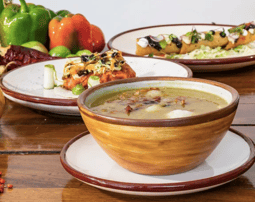Let me introduce myself, I'm chef Karla Irlette Castro Reynoso, Executive Chef of La Cueva de Don Cenobio, Sauza's Reaturant. I will tell you about one of the most important dates for us Mexicans, the night of September 15th, in which we shout "Long live Mexico!" to remember the one who started the battle for the Independence of Mexico, priest Miguel Hidalgo.

Us Mexicans celebrate and commemorate this holiday in a very colorful way, full of tradition: marichi music, traditional outfits, regional dances and yes, lots of food.
As in many of our parties, food is the star that night and it "dresses up", flaunting our cuisine which, since 2010, was declared an Intangible Cultural Heritage of Humanity by the UNESCO.
This is the night when we all Mexicans enjoy the gastronomy from our country and the kitchens of our homes offer a tradicional feast.
Here are some of the dishes that we prepare:
Chiles en nogada
It's one of the most representative dishes of Mexico and there are different theories about its origin. One of the most famous is that the nuns of the convent of Santa Monica, in Puebla, created it in honor of Agustín de Iturbide, to celebrate the signing of the treaties of Córdoba. Whether the story is true or not, this is a dish that we "show off" during this celebration, both for the history of the nuns, as well as for its colors: green (pepper), white (castile nut sauce) and red (pomegranate grains), our National colors. In order for it to be a real Chile en Nogada, it has to be done with:
- Peppers from the San Martín Texmelucan area
- Castile nuts from Calpan
- Fruits from the region of the volcanoes
The season of Chiles en Nogada begins at the end of July and ends at the end of September.
Pozole
Its name is of Nahuatl (language of the Aztecs) origin and means foam. Although it's a typical dish of Mexico City, it has been adopted and modified with the ingredients and tastes of each region. For example, in Guerrero, they add green tomato; in Michoacán, pork rind; in Jalisco, a chili that gives it a red color; in Colima and Sinaloa, it's of white color. Regardless of this versions, it's a dish we all love.

Moles
The mole poblano is awarded as one of the best mole in Mexico and it's one of the most representative dishes of this country.
Oaxaca doesn't stay far behind, since it's got 7 moles, one for each region:
- Yellow, which is traditionally served with chochoyotas
- The black one, made with chihuacle, which is the "star" chile
- Slightly red (Coloradito)
- Green
- Chichilo, the least known one, but one of the tastiest
- Mancha-manteles (tablecloths stainer), also typical of Puebla
- Red
Tamales
Its name also comes from Nahuatl and means wrapped. It can be wrapped with corn, banana, avocado or maguey leaves, or even with aluminum and plastic. They can be sweet or salty, and the fillings are innumerable, it all depends on each cook's seasoning and cooking.
Try some of this dishes at the Mexican Night that we will host at our Quinta Sauza
/Campa%C3%B1as/15%20y%2016%20de%20sept/Bandereas,%20traje%20tipioco%20quinta,%2015%20septiembre.jpg?width=223&name=Bandereas,%20traje%20tipioco%20quinta,%2015%20septiembre.jpg)
If you want to try some of these dishes, I invite you to join us during our Mexican Night, at Quinta Sauza. We will have a buffet where you will find some of these traditional Mexican dishes, and many more!
We invite you to shout “Viva Mexico!” with us, accompanied by the taste and seasoning of our restaurant, La Cueva de Don Cenobio, where we add our own touch to each of the dishes. Come and you will be surprised, but above all, you will live a night of folklore, tradition and fun that you'll never forget!
.png?width=50&height=50&name=10.CS-Redondo%20(1).png)
